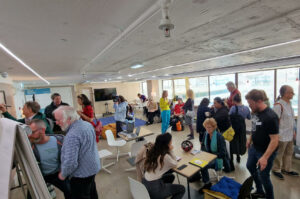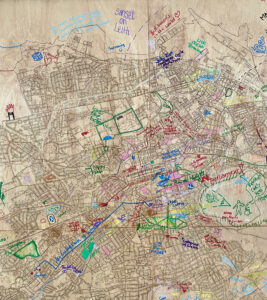Reflecting on Our Urban Rooms
How can communities engage and positively steer development in their neighbourhoods, towns and cities?
Written by John Brennan
Much can be achieved online, but a physical space is critical to meet, collaborate, engage, plan and create. Such a place, in control of the communities it serves, can be called an ‘urban room’. It is a dedicated space for people to imagine and realise transformed neighbourhoods and cities. Exploring this idea of urban room has been central to our work in Community Consultation for Quality of Life, and here we reflect our recently concluded pilot projects across the four nations.
Over eight months we created four urban rooms in Reading, Cardiff, Edinburgh and Belfast. From these experiences, we are now testing our understanding of what makes for a successful urban room. I won’t miss this opportunity to credit Edinburgh as a birthplace for the urban room. It would be no exaggeration to describe Patrick Geddes as a polymath who, at the turn of the nineteenth century, was a sociologist, conservationist, educationalist and town planner. Geddes’ Outlook Tower in the shadow of the castle was realised in 1892 as an ‘urban observatory for the modern age’ and ‘world’s first sociological laboratory’.
 Image 1 – urban room photo – credit Ruchit Purohit
Image 1 – urban room photo – credit Ruchit Purohit
To understand urban development, Geddes deliberately decamped to live in the urban slums of Edinburgh’s Old Town, with the express intention of inspiring and mobilising his community to action. His Edinburgh Social Union was designed to enable residents to understand, represent and transform their own neighbourhoods and the Outlook Tower was the dedicated urban room where this activity could be nurtured and developed.
In the present day, the Urban Rooms Network neatly describes an urban room as a ‘..space where people can come together to help create a future for their local area.’ Following from this, our urban rooms shared a focus on the built environment, with an open door, supporting creative practice and being embedded in the communities they serve.
A real draw of our pilot projects was celebrating the diverse practices that came from the distinct places in which we operated our urban rooms . This didn’t only apply to the neighbourhoods and contexts in which we worked but also the diverse social and political landscapes of our four nations.
The University of Reading, established Your Place Our Place in the Town’s Broad Street Mall. This pilot tested the classic ‘shopfront’ urban room, with a rich programme of events that tapped into the life of the mall.
Cardiff University created Community Voices Cardiff, which explored an urban room embedded in a dedicated community centre.
The University of Edinburgh hosted Our Edinburgh Neighbourhood, combining a meeting room in the town centre with community outreach in local neighbourhoods.
In Belfast, Ulster University created Your City Your Voice within a local authority owned building of some significance in central Belfast.

Image 2 – Map – credit John Brennan
Overall, each of the project’s urban rooms had their own physical characteristics that played out in their own ways, reflecting the preoccupations of each project partner. I was able to visit Reading and Belfast as well as host our own project in Edinburgh. There were many similarities. All the rooms were welcoming and inclusive. In Reading, special provision was made for the neurodiverse, and all were focused on moving beyond community ‘consultation’ to testing and promoting methods to create meaningful participation and engagement.
Every urban room we established was a welcoming place, balancing crafted exhibitions, precise digital tools and very physical and immediate ways for visitors to make their mark. In Edinburgh we etched an oversize plywood map of Edinburgh and provided acrylic pens for everyone to craft, scribble and tell us what they thought important.
We intended our urban rooms to differ in the way they embedded themselves in their respective communities. Reading used a city centre location with high footfall whilst Belfast, also located centrally, worked with existing programmes of events in a community building. This was also the case in Cardiff but very much at the neighbourhood scale. Edinburgh was more of a hybrid, testing a central urban room as a place of discourse and production, but reaching out into local communities too.
So what is the headline from our experiences running these urban rooms? There’s a demand by communities for places to debate and create.
A challenge we all faced was dealing with demand in the finite time our rooms were operational. Architecture Centres work well but we’re sensitive to places that spend more time on transmit rather than receive. We tested our urban rooms to build capacity; to move on from passive participation to active engagement by communities to shape their own neighbourhoods. We can conclude that although urban rooms will share some values and characteristics, each should respond in their own ways to the particular places and communities they serve.
John Brennan is a Professor of Sustainable Architecture, Edinburgh Futures Institute Fellow, and Programme Director MSc Advanced Sustainable Design at the Edinburgh School of Architecture and Landscape Architecture, The University of Edinburgh : Edinburgh College of Art.
Image 1 – urban room photo – credit Ruchit Purohit
Image 2 – Map – credit John Brennan